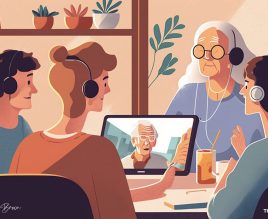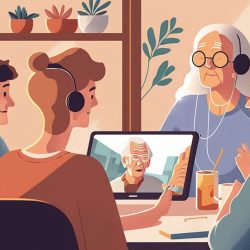Table of Contents
ToggleOlder Adults Digital Literacy pertains to the ability of seniors to effectively use digital tools and the internet. This includes skills ranging from basic computer operation, smartphone navigation, and online safety to more complex tasks like using social media platforms, online banking, telehealth services, and e-commerce portals.
The rise of technology in nearly every facet of daily life has rendered digital literacy not just a desirable skill but a requisite one. However, despite its ever-growing importance, there’s an evident gap in Older Adults Digital Literacy, a discrepancy that can inadvertently exacerbate social isolation, restrict access to essential services, and magnify health disparities in an already vulnerable population.
Addressing this issue requires a multi-faceted approach. We need comprehensive educational programs and strategies that are tailored to the learning needs of older adults that address their unique challenges and reservations about technology. Such programs must be coupled with the development of senior-friendly technologies and interfaces that are intuitive, accessible, and uncomplicated.
In this article, we will delve deeper into these strategies, provide real-life examples and case studies, and propose a plan for how we, as a society, can help bridge the digital divide for older adults.
Understanding the Digital Divide
Let’s take a comprehensive look at of digital divide’s impact on older adults, the factors contributing to it, and the demographics most affected. The aim is to develop an in-depth understanding that will help formulate effective strategies to bridge this divide, enabling older adults to participate fully in the digital world.

The Impact of the Digital Divide on Older Adults
The digital divide doesn’t merely represent a technological disadvantage for older adults—it has tangible and far-reaching effects on their lives. From causing social isolation to restricting access to essential services and impacting their health and well-being, the divide permeates multiple dimensions of an older adult’s life. Let’s examine each of these impacts in detail to understand the scope of the problem we’re grappling with.
Social Isolation
For older adults, the digital divide can lead to acute social isolation. As society shifts towards digital communication, those lacking digital literacy can feel left out. The inability to connect through social media or video calls means they miss out on communal exchanges, causing a sense of loneliness and disconnect. This is a serious concern as social isolation in older adults has been linked to various physical and mental health problems, including depression and cognitive decline.
Limited Access to Services
The digital divide can also limit older adults’ access to vital services. Many amenities and utilities, like online shopping, banking, or even booking appointments, are now predominantly digital. Older adults struggling with digital literacy face difficulties accessing these essential services, making them increasingly reliant on others for basic needs. This not only limits their independence but can also lead to feelings of helplessness and frustration.
Health and Well-being
Lack of digital literacy can severely impact older adults’ health and well-being. Telemedicine, online health resources, and fitness classes have become standard healthcare components. Those unable to navigate the digital world miss out on these health benefits. Furthermore, social isolation resulting from digital illiteracy can lead to mental health issues, further exacerbating the problem.
Factors Contributing to the Digital Divide
Socioeconomic status, educational attainment, and geographical location all play pivotal roles in determining an individual’s digital literacy and access. Understanding these factors is critical to developing tailored, effective solutions to bridge the divide. Let’s delve into each of these contributors.
Socioeconomic Status
Older adults with lower socioeconomic status often lack the resources to purchase digital devices or afford a reliable internet connection. Consequently, they are at a disadvantage in adopting digital technologies. In addition to affordability issues, they may also lack the time or support to learn and adapt to new technologies, further widening the digital divide.
Education
Education plays a significant role in the digital divide. Older adults with a lower level of education often struggle more with understanding and utilizing digital technology. This lack of digital literacy not only restricts their access to online resources but also limits their ability to adapt to the rapidly evolving digital landscape.
Geographical Location
Geographical location significantly influences the digital divide among older adults. Particularly, those residing in rural areas face a greater challenge due to limited access to reliable, high-speed internet services. This lack of infrastructure further compounds the issue, leaving a substantial segment of older adults digitally disconnected.
Demographics of Older Adults Most Affected
The digital divide doesn’t affect all older adults equally. Certain demographics within this age group, such as the ‘oldest old (those above 80) and those residing in rural areas, are disproportionately impacted. To ensure our efforts to bridge the divide are effective, it’s important to understand which groups are most affected.

Age Groups
Among older adults, the ‘oldest old’, typically those over 80 years old, are most affected by the digital divide. This group often faces additional barriers, such as physical or cognitive impairments, that make it even more challenging to learn new technologies. Moreover, this age group experienced the advent of the internet and digital technologies relatively later in life, making it harder for them to adapt and catch up.
Rural vs. Urban Populations
Geographical disparities also contribute to the digital divide among older adults. Those in rural areas, where access to high-speed, reliable internet services may be limited or non-existent, face greater challenges. The lack of necessary infrastructure and resources in these areas makes it more difficult for older adults to access digital services, learn new technologies, and stay connected. This is a stark contrast to their urban counterparts, who generally have better access to such services. Therefore, geographical location plays a significant role in the extent of the digital divide faced by older adults.
Community Engagement Initiatives
Community engagement is a powerful tool in bridging the digital divide for older adults. By fostering a supportive environment that prioritizes digital inclusion, we can help older adults gain the skills and confidence needed to navigate the digital world. This section explores community initiatives designed to promote digital access, partnerships with organizations and businesses, and inspiring success stories. Together, these components illuminate a roadmap for other communities looking to bridge the digital divide in their midst.
Local Programs Promoting Digital Access
Local programs form the backbone of any community-driven initiative. When it comes to promoting digital access for older adults, public libraries and senior centers play a vital role. They often serve as initial touchpoints where older adults can get acquainted with digital technologies in a familiar and supportive environment. Let’s look at how these local institutions help bridge the digital divide.
Public Libraries
Public libraries have long served as community hubs for learning and engagement. With the digital divide widening, many libraries have expanded their roles to include digital literacy training for older adults. They offer free internet access, computer courses, and one-on-one tech support to help older adults become comfortable with digital technologies. This public resource can play a pivotal role in bridging the digital divide in local communities.
Senior Centers
Senior centers are another crucial component of local digital literacy efforts. These centers, specifically designed to cater to the needs and interests of older adults, can host digital literacy workshops and provide resources like computers and tablets for practice. The supportive and peer-based learning environment can ease the apprehension associated with learning new technologies, empowering older adults to take digital strides confidently.
Partnerships with Organizations and Businesses
Bridging the digital divide is a collaborative effort that benefits from partnerships with various organizations and businesses. Nonprofits, NGOs, and technology companies can bring resources, expertise, and unique perspectives to the table, significantly bolstering community efforts. These collaborations can take many forms, from donating devices to conducting workshops or developing user-friendly software for older adults.
Nonprofits and NGOs
Nonprofits and NGOs can significantly contribute to bridging the digital divide. These organizations often possess the experience, dedication, and expertise to understand and address the unique challenges older adults face in the digital world. Their involvement in digital literacy initiatives can range from sponsoring training programs to donating devices, making them indispensable partners in this effort.
Technology Companies
Technology companies have a vested interest and social responsibility to address the digital divide. Their contributions can be multi-fold: providing financial support, donating devices, developing age-friendly software, or even offering training programs. Through active involvement and collaboration, these companies can directly contribute to making the digital world more accessible for older adults.
Success Stories and Case Studies
To understand how we can effectively address the digital divide, it’s essential to look at successful initiatives and learn from them. These success stories, whether from local initiatives or national programs, provide valuable insights into what works. By studying these cases, we can glean practical strategies and adapt them to other contexts.
Local Initiatives
Across the country, numerous local initiatives have successfully addressed the digital divide among older adults. These programs often harness community resources and adapt to the unique needs of their older adult populations. Their strategies, challenges, and successes can serve as practical roadmaps for other communities tackling the digital divide.
National Programs
Several national programs have also taken up the mantle of digital literacy for older adults. These initiatives typically leverage vast networks and resources, enabling them to reach a larger audience. By examining their strategies and impact, we can gather valuable insights to guide our efforts in bridging the digital divide for older adults.
Online Support Groups for Older Adults
Online support groups play a pivotal role in enriching the lives of older adults navigating the digital world. These groups offer a platform for emotional support, educational resources, and social connections, contributing significantly to the well-being of their members. They vary widely, encompassing health-related groups, caregiver support, and hobby or interest circles, offering something for everyone.

Benefits of Online Support Groups
Online support groups offer a unique blend of emotional, educational, and social benefits for older adults. They can serve as safe spaces where individuals can share experiences, learn from others, and cultivate meaningful connections, all while being in the comfort of their homes. Let’s look closer at these benefits and understand why online support groups are a valuable tool for older adults transitioning into the digital age.
Emotional Support
Online support groups can provide invaluable emotional support to older adults. Whether dealing with health issues, grieving a loss, or facing the challenges of aging, sharing experiences with people who understand can be a comforting and healing experience. This emotional support can foster resilience and help individuals cope with their circumstances more effectively.
Educational Resources
Many online support groups offer a wealth of educational resources. These could range from health information, caregiving tips, or tutorials on digital skills. Having access to reliable, curated information can empower older adults, enhancing their independence and confidence.
Social Connections
One of the key benefits of online support groups is the social connection they offer. Especially for those who may experience social isolation—either due to mobility issues, geographical distance, or the digital divide—these groups can help maintain a sense of community and connection.
Types of Support Groups Available
Online support groups come in various forms, catering to a broad spectrum of needs and interests. From groups focused on health-related issues to caregiver support, hobby, and interest groups, the digital world offers an array of options. Understanding the diversity of these groups can help older adults find a platform that resonates with their needs and preferences.
Health-Related
Health-related online support groups can provide a platform for older adults to share experiences, learn about their conditions, and navigate their health journeys together. These groups often provide resources, expert advice, and a community of individuals facing similar challenges.
Caregiver Support
For those taking care of a loved one, online caregiver support groups can be a lifeline. They offer a space to share experiences, seek advice, and access resources—all while connecting with others who truly understand the unique challenges caregivers face.
Hobby and Interest Groups
Online groups centered around hobbies or interests can bring immense joy and purpose to older adults. Whether it’s gardening, reading, crafting, or digital photography, these groups can provide learning opportunities, a sense of community, and an outlet for creative expression.
Choosing the Right Support Group
With numerous online support groups available, choosing the right one can be a daunting task. But this choice is critical as the right group can offer a supportive, enriching experience that meets individual needs. Factors like personal preferences, the focus of the group, and the platform used can all influence this decision. Let’s explore these factors in detail.
Assessing Needs and Preferences
Choosing the right group starts with a clear understanding of personal needs and preferences. Whether seeking emotional support, information, or social connections, understanding these needs can guide older adults towards a group that fulfills them.
Evaluating Online Platforms
Another important aspect to consider is the online platform the group uses. Ease of use, accessibility features, and the level of privacy provided are important considerations. Some older adults may prefer platforms they are already familiar with, such as Facebook groups, while others might be open to learning new platforms if they offer superior features or better privacy.
Digital Literacy Training Programs
Digital literacy training programs designed for older adults are an important aspect of bridging the digital divide. In this section, we delve into the significance of digital literacy training, the variety of programs available, and tips on selecting the right program that aligns with individual needs and preferences.
Importance of Digital Literacy Training
Understanding the digital world is not just about learning to use technology; it’s about building confidence, fostering connections, and ensuring access to essential services that have shifted online. Digital literacy training can empower older adults to use technology effectively and safely, enabling them to participate in the digital world and reap its benefits.
Whether it’s staying connected with loved ones, accessing online services, or engaging with online support groups, digital literacy skills can significantly enhance the quality of life for older adults. Furthermore, such training can mitigate feelings of isolation and exclusion, contributing positively to mental and emotional well-being. As we explore further, we will see the types of training programs available and how they cater to diverse learning needs.
Types of Training Programs
A one-size-fits-all approach doesn’t work when it comes to digital literacy training. Hence, a variety of training programs exist, ranging from group classes to one-on-one sessions and online resources. Understanding these different formats can help older adults find a program that best fits their learning style and comfort level with technology, ensuring they gain the most out of their digital literacy journey.
Group Classes
Group classes offer a communal learning environment, where participants can learn from an instructor and each other. These classes often cover a wide range of topics, from basic computer skills to using social media or managing online security.
One-on-One Sessions
For those who prefer individualized attention, one-on-one sessions can be highly effective. These sessions can be tailored to the learner’s pace, skill level, and specific learning goals, making them a highly personalized learning experience.
Online Resources
Online resources, such as tutorials, webinars, or interactive learning platforms, offer flexibility and convenience. They can be accessed anytime, anywhere, and often allow learners to revisit the material as needed.
Tips for Selecting a Training Program
Choosing the right digital literacy training program is a crucial step in the learning journey. The best program should align with the individual’s learning style, comfort level with technology, and specific learning goals. With numerous options available, how does one select the right program? Here, we offer some practical tips to guide this decision-making process.
Assessing Individual Needs
Identifying individual needs and learning goals is the first step in choosing a suitable training program. Whether it’s learning to send emails, use social media, or understand online security, defining these goals can guide the selection process.
Comparing Available Options
Once individual needs are clear, comparing different training programs can help in making an informed choice. Factors such as the format of the program, the topics covered, the pace of learning, and the resources provided should be considered. With careful selection, the chosen program can serve as a powerful tool in equipping older adults with the digital skills they need to navigate the digital world confidently.
Implications and Future Developments
The implications of bridging the digital divide for older adults and future developments in this sphere are manifold. As technology continues to advance and permeate every aspect of our lives, its role in mitigating the digital divide becomes increasingly significant. However, it’s not without its challenges and opportunities.
Emerging technologies specifically designed for older adults, are also on the horizon, promising innovative solutions to the unique barriers this demographic faces. Let’s explore these facets further, and glimpse into the potential future of digital engagement for older adults.
The Role of Technology in Bridging the Digital Divide
Technology plays a pivotal role in bridging the digital divide. From developing intuitive devices and software that are easier for older adults to use to virtual reality and AI solutions that can aid in learning and accessibility, technology holds the key to making the digital world more inclusive. Beyond devices and software, the internet itself, through online support groups and digital literacy programs, is a powerful tool for addressing this divide.
Potential Challenges and Opportunities
While technology offers tremendous opportunities, it also presents challenges. Issues such as online safety, privacy concerns, and the rapid pace of technological change can be daunting for older adults. However, these challenges also open up opportunities for innovative solutions that address these specific concerns, fostering an environment where older adults feel safe, confident, and empowered in their digital interactions.
Emerging Technologies for Older Adults
As the focus on the digital inclusion of older adults increases, emerging technologies are being developed with this demographic in mind. From AI-driven personal assistants to virtual reality experiences that foster social connections, the future of digital engagement for older adults is exciting and promising. These technologies aim to not just bridge the digital divide, but also enhance the quality of life for older adults in a rapidly evolving digital world.
Conclusion
The digital divide poses a significant challenge for older adults, but through community engagement, online support groups, and digital literacy training, we can bridge this divide. Addressing this issue is undeniable, as it impacts the social health and well-being of older adults.
However, overcoming this divide is not a solo effort but requires a collective push from local programs, organisations, businesses, and technology itself. Furthermore, tailored digital literacy programs are vital for empowering older adults with the skills and confidence they need to navigate the digital world effectively.
If you’re an older adult or a caregiver, we encourage you to explore local initiatives, online support groups, and digital literacy training programs available in your community. Harnessing the power of technology is not just about learning to use devices and software but about opening doors to better health, deeper connections, and improved quality of life.
Remember, every small step towards digital literacy matters, and there is a wealth of resources out there to support you on this journey. So let’s embrace the digital age together, fostering an inclusive, connected, and digitally confident community of older adults.
FAQ
What is the digital divide?
The digital divide refers to the gap between those who have access to computers and the internet and those who do not. It also encompasses the differences in digital literacy levels and the ability to effectively use technology.
How can older adults overcome barriers to digital access?
Overcoming barriers to digital access can involve various strategies such as enrolling in digital literacy training programs, participating in online support groups, leveraging resources from local libraries and senior centers, and seeking assistance from family members or caregivers.
What resources are available to help older adults improve their digital skills?
Resources range from local programs like classes at public libraries or senior centers, to online platforms offering tutorials and courses. Partnerships with nonprofits, NGOs, and tech companies also often provide resources and support for older adults.
How can family members and caregivers support older adults in using technology?
Family members and caregivers can play a key role by encouraging and assisting older adults in their digital literacy journey. This can involve teaching them how to use devices and apps, guiding them to appropriate resources, and creating a supportive and patient environment for learning.
References
- https://www.investopedia.com/
- https://www.ncbi.nlm.nih.gov/
- https://journals.sagepub.com/

















